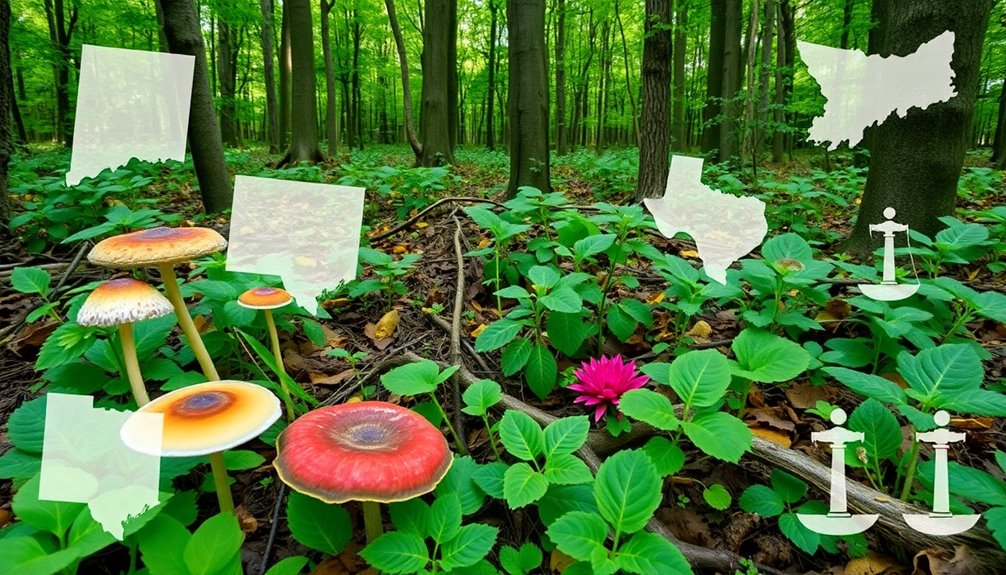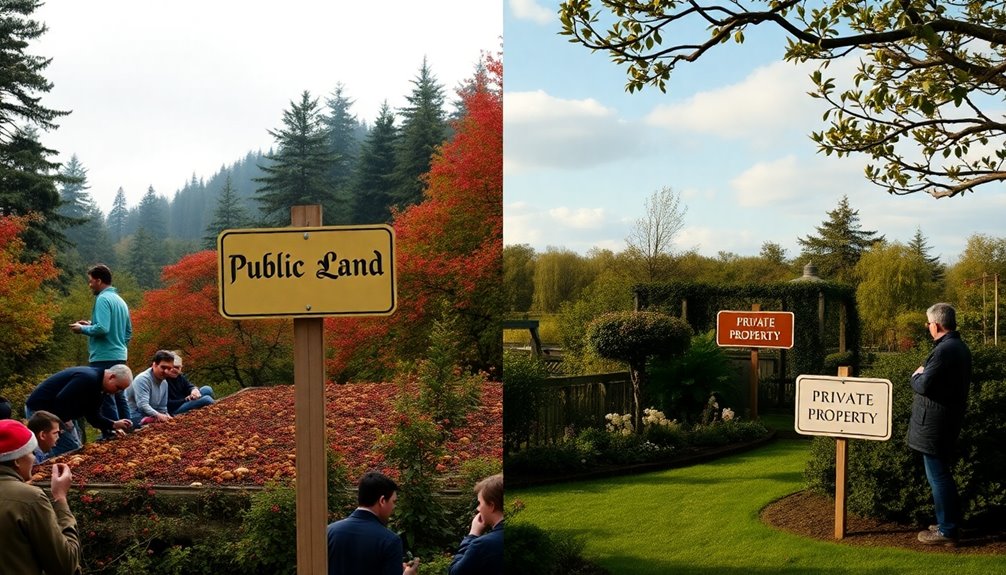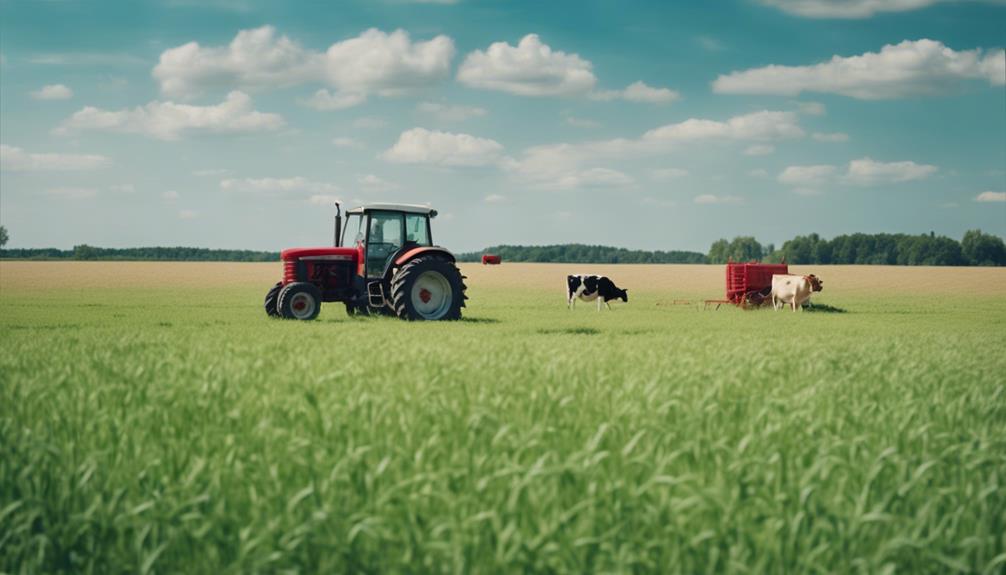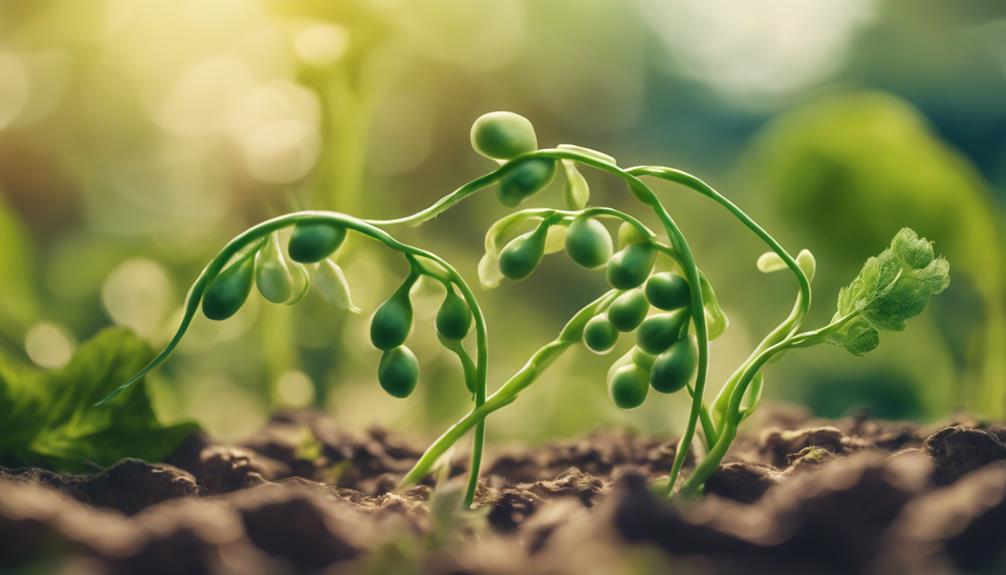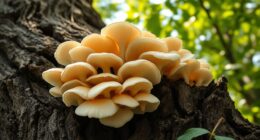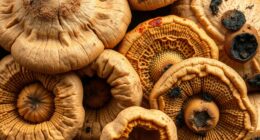When you think about foraging, it's crucial to understand the legal guidelines that vary by state. Some states, like Arkansas and California, have strict rules against foraging on state-owned lands, while others, like Oregon, permit limited collection of wild foods. If you're planning to forage, knowing these regulations is essential to avoid potential fines or legal issues. But what about states with evolving laws, like New York? As discussions unfold, you might find that the rules could change. Understanding these nuances can significantly impact your foraging experience.
Key Takeaways
- Foraging laws vary by state; check specific regulations for state parks, national forests, and private lands before foraging.
- Some states, like Arkansas and California, impose strict bans on foraging in state-owned lands, while others permit limited harvesting.
- National parks generally prohibit foraging, with 13 out of 59 parks banning all activities; verify rules for each park.
- Always obtain necessary permits for foraging in national forests, usually costing at least $20, and check local rules for wildlife refuges.
- Familiarize yourself with local foraging resources and guides to ensure proper identification and ethical harvesting practices.
Introduction

Foraging offers a unique connection to nature and a chance to explore local ecosystems, but navigating the legal landscape can be tricky. Laws regarding foraging vary significantly from state to state, and understanding these differences is crucial before you head out with your basket.
In states like Arkansas and California, foraging on state-owned lands is nearly prohibited, while Oregon allows you to harvest small quantities of non-endangered wild foods for personal use. It's essential to know that New York state parks impose a blanket prohibition on foraging, although there are ongoing efforts to change this. Additionally, urban foraging initiatives have emerged, promoting community engagement and awareness about the benefits of foraging.
Moreover, federal regulations complicate the landscape further. The National Park Service generally prohibits foraging unless you obtain specific permission, while National Forests require permits you can only get in person at a Forest Service office. It's important to note that foraging regulations vary significantly across different types of public lands, which can lead to confusion for foragers.
Even National Wildlife Refuges have varied rules—some permit harvesting berries, fruits, and nuts, while others ban foraging entirely. Being aware of these state and federal laws can help you enjoy your foraging adventures responsibly and legally, ensuring a sustainable relationship with nature.
Always check local regulations before foraging to avoid fines and make the most of your experience.
Legal Framework

Understanding the legal framework surrounding foraging is essential for anyone looking to explore this rewarding activity. Federal regulations, such as those enforced by the National Park Service (NPS), prohibit the possession, removal, or disturbance of plants in national parks unless permitted by the park superintendent.
Each park has its own set of rules, with some banning foraging entirely while others allow it under specific conditions. State and local regulations also vary widely. For instance, Alabama State Parks prohibit all foraging, while Oregon permits harvesting small amounts of non-endangered wild foods. You may need to check local rules, as regulations can differ significantly even within the same state. Some areas require permits for foraging specific species, like American Ginseng. It is also important to obtain permission before foraging on private property to respect land ownership.
When foraging on public lands, such as national forests or wildlife refuges, be aware that permits may be necessary, and restrictions on quantity apply. Urban spaces often have their own complex regulations. It's crucial to respect these rules to avoid stiff fines or legal penalties and to ensure sustainable practices. Always prioritize the protection of native species and biodiversity in your foraging endeavors. Foraging can also encourage individuals to connect with their local ecosystems, fostering a sense of community awareness.
Main Guidelines

Navigating the rules around foraging can be straightforward once you know the main guidelines to follow.
First, check if foraging is allowed in the area you plan to visit. In National Parks, foraging is generally prohibited unless specified by the park superintendent. Remember, 13 parks ban foraging entirely, while 46 allow some harvesting with restrictions. Some parks may limit the quantity or specify certain wild foods that you can't collect.
In National Forests and public lands, you often need a permit, which you can purchase in person. This permit typically covers personal use, but commercial foraging may have different requirements. Be aware that certain species, like American Ginseng, are completely off-limits.
State Parks have varying rules; while some states prohibit all foraging, others, like Oregon, allow limited harvesting of non-endangered species. Always check local regulations before you start.
Wildlife Refuges have their own set of guidelines, which can vary widely. Some may allow foraging for berries and nuts, while others may not. It's crucial to consult the specific refuge's rules before foraging.
Following these guidelines ensures you forage legally and responsibly.
Best Practices

When venturing into foraging, it's essential to adopt best practices that ensure both your safety and the sustainability of the environment. Start by familiarizing yourself with local foraging laws, as regulations can vary widely. Check the specific rules for the type of public land you're on, whether it's a national park or a wildlife refuge, and don't hesitate to contact local park managers for clarification. Additionally, be aware that regulations may be in place to protect endangered species and their habitats, which can impact foraging activities.
When foraging, only take plants that grow abundantly. Use tools like knives or scissors to minimize damage to the plant and its surroundings. Always leave enough for wildlife and other foragers; avoid stripping plants and refrain from harvesting roots or taking bark from live trees. Ensure the plants you choose are healthy and vibrant.
Safety is paramount, so be 100% sure of a plant's identity by cross-referencing at least two reliable sources. Know which parts are edible and non-toxic, and avoid areas that might've been treated with pesticides.
Common Mistakes to Avoid

Foragers often overlook key aspects of local regulations, which can lead to unexpected legal troubles. One common mistake is assuming that foraging rules are the same everywhere. Each state and type of federal land has its own regulations; for instance, foraging is usually prohibited in National Parks without explicit permission. Ignoring these restrictions can result in serious fines or even jail time.
Another mistake is foraging on private property without obtaining permission. Always confirm ownership and gain access rights to avoid legal issues.
Additionally, many foragers fail to check the specific guidelines for National Forests and Wildlife Refuges, where permits may be required.
Furthermore, misidentifying plants can pose health risks. Always ensure you correctly identify a plant before harvesting it, as some species are toxic.
Lastly, don't neglect to stay informed about changing regulations. Local laws can shift, and being unaware doesn't protect you from penalties.
Special Considerations

What should you keep in mind before heading out to forage? First, familiarize yourself with the regulations specific to the area you plan to explore. In National Parks, for example, the National Park Service prohibits most foraging unless explicitly allowed by the park superintendent.
Remember that each park may have unique rules, so check the Superintendent's Compendium for the latest updates.
Next, consider the differences in state and local regulations. Some states, like Alabama, completely ban foraging, while others may allow it with restrictions.
Always confirm what's permissible in your chosen location, as local laws can vary significantly.
Also, think about the ethical implications of your foraging. Prioritize harvesting invasive species when possible to help protect native ecosystems.
Only take what you need, ensuring that the plants you forage are abundant and not endangered.
Lastly, be aware that your actions might impact other visitors' experiences. Respect the environment and the rules in place to protect it.
Resources and References

Numerous resources are available to help you navigate the complex world of foraging regulations. First, familiarize yourself with the National Park Service's rules, which generally prohibit foraging under 36 C.F.R. § 2.1. Some parks allow exceptions, so check with individual park superintendents.
Be aware that 13 out of 59 national parks ban all foraging, while others impose quantity restrictions.
In National Forests, you'll need a permit for foraging, available at Forest Service offices for at least $20. Regulations differ across locations, so always verify local rules.
Some National Wildlife Refuges permit foraging for specific items, and TVA public lands allow the collection of non-poisonous mushrooms, berries, and nuts for personal use.
State parks vary widely; for instance, Alabama prohibits all foraging, while Oregon permits small quantities of non-endangered wild foods. Always check specific park regulations and local laws, as they can differ even within the same state.
To enhance your foraging experience, use resources like Falling Fruit, a global map of foraging locations, and consult authoritative guides to identify safe, edible plants.
Following ethical foraging practices is essential to minimize environmental impact.
Conclusion
When foraging, always stay informed about your state's regulations to avoid legal issues. Remember, responsible foraging not only protects the environment but also ensures that you can enjoy nature's bounty safely and sustainably. By following the guidelines and best practices outlined, you can forage with confidence. Keep learning and respect the land, and you'll contribute to the preservation of our natural resources for future generations. Happy foraging!

